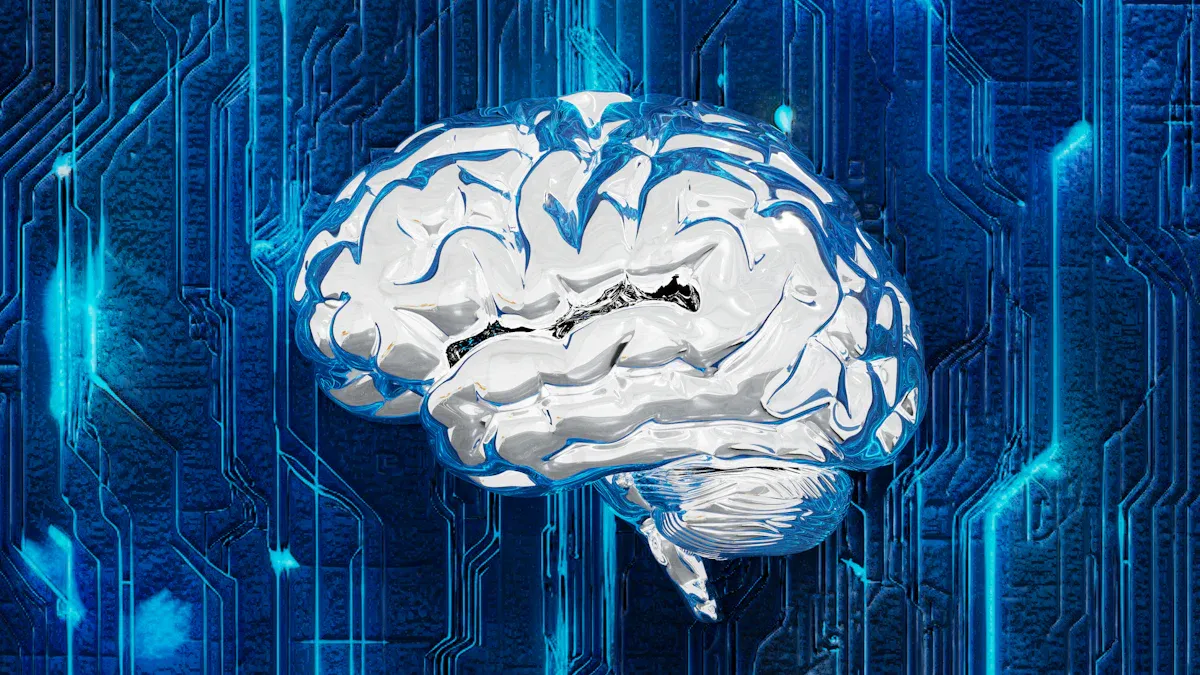Elevating Green Procurement in Electronics using AI-Driven Digital Platforms

AI-driven digital platforms are transforming how electronics companies implement green procurement and approach sustainable sourcing. The electronics sector faces mounting challenges, including complex supply chains, environmental impacts from raw material extraction, and rising e-waste. Leading manufacturers invest in recyclable components, energy-efficient production, and circular economy models to address these concerns. Apple and other industry leaders set ambitious goals for carbon neutrality and renewable energy adoption, while strict regulations in North America and Europe drive innovation. Companies now recognize that digital transformation can help align green procurement practices with business objectives and sustainability targets.
Key Takeaways
AI-driven platforms help electronics companies choose sustainable suppliers by analyzing environmental and social data quickly and accurately.
Using AI improves transparency by tracking products and supplier actions, making it easier to trust and verify green procurement practices.
Automation through AI reduces manual work, speeds up processes, and helps companies save costs while supporting sustainability goals.
AI tools monitor compliance with environmental rules in real time, helping companies avoid risks and meet regulations effectively.
Successful green procurement with AI requires clear leadership, employee training, and responsible use of AI to ensure fairness and trust.
Green Procurement Overview

Definition
Green procurement, sometimes called sustainable procurement, means buying products and services that help protect human health and the environment. This approach looks at the entire life cycle of a product. Companies consider how raw materials are taken from the earth, how products are made, packaged, shipped, used, and finally disposed of or recycled. The main goal is to use resources wisely, reduce waste, and choose renewable or recycled materials whenever possible. By doing this, organizations support environmental protection, social responsibility, and economic strength.
The EPA’s Environmentally Preferable Purchasing (EPP) program encourages organizations to use standards and ecolabels that address environmental impacts across a product’s life cycle. Programs like EPEAT and ENERGY STAR help companies choose electronics that use less energy, contain fewer toxic materials, and are easier to recycle. These standards guide buyers to select products that do less harm to the environment from start to finish.
Some well-known certifications and programs include:
ENERGY STAR: Promotes energy-efficient electronics.
EPEAT: Ensures responsible sourcing and recyclability.
GREEN SEAL: Focuses on safer, sustainable products.
LEED: Sets standards for green building and materials.
Importance in Electronics
The electronics industry faces unique challenges. Manufacturing electronics often uses rare materials and creates waste that can harm the environment. Green procurement helps companies lower their impact by choosing products that use less energy, last longer, and can be recycled or reused.
Research shows that green purchasing improves sustainability performance and matches what many customers want. Companies that use green procurement often see better market share and stronger reputations. Studies also find that using electronic procurement technology makes it easier to follow green procurement practices. This leads to a greener supply chain and helps companies meet strict rules about energy use, recycling, and safe materials.
By making smart choices, electronics companies can reduce pollution, save energy, and support a healthier planet for everyone.
AI Applications

Supplier Evaluation
AI-driven platforms have changed how companies evaluate suppliers in the electronics industry. These platforms use structured and unstructured data to measure supplier sustainability performance. They look at sustainability credentials, certifications, and compliance records. AI tools help organizations align procurement with sustainability goals while keeping costs competitive.
AI platforms provide sustainability scores for suppliers. These scores help identify partners with strong environmental practices.
Machine learning models detect gaps between what suppliers report and what they actually do. This helps prevent greenwashing and ensures compliance.
Natural language processing (NLP) monitors regulatory changes worldwide. Procurement teams stay updated on new rules and standards.
AI-driven systems track many sustainability metrics. Some even use computer vision to check working conditions, which increases transparency.
Several companies use these tools. Samsung Electronics uses AI-based supplier evaluation systems to improve supplier selection. Audi uses Prewave’s AI to monitor supplier risks, such as labor violations and environmental hazards, by analyzing online content in many languages. Platforms like GEP SMART, Ivalua, Jaggaer, and SAP Ariba offer AI-powered procurement solutions that include supplier management, analytics, and risk prediction. These tools help procurement teams make better decisions based on real-time data.
AI automates the collection and verification of compliance data across complex supply networks, making supplier evaluation faster and more reliable.
ESG Metrics Analysis
AI helps companies analyze Environmental, Social, and Governance (ESG) metrics for electronics suppliers. It automates the collection and structuring of ESG data from many sources, such as ERPs, sustainability reports, and supplier databases. Machine learning and NLP improve data accuracy by finding errors and aligning information with global ESG frameworks like GRI, SASB, and CSRD.
AI integrates data from corporate websites, news stories, social media, and even satellite images. This gives a full picture of supplier performance.
Real-time monitoring uses IoT devices and live data feeds. Companies can track emissions, water use, labor practices, and compliance as they happen.
AI reviews company compliance with ESG reporting requirements. It helps organizations meet standards like CSRD and TCFD.
Predictive analytics spot ESG risks early, such as environmental violations or labor issues.
Generative AI also plays a role. It automates the creation of procurement documents, such as RFPs and contracts. This reduces errors and saves time. AI extracts key contract information, making it easier to manage supplier relationships and ensure compliance with green criteria.
AI-driven ESG analysis leads to measurable outcomes. Companies see reduced emissions, better resource use, and improved transparency in their supply chains.
Carbon Emissions Management
Managing carbon emissions, especially Scope 3 emissions, is a major challenge in electronics supply chains. AI-driven platforms help companies collect and standardize emissions data from suppliers. They use advanced analytics, machine learning, IoT, and cloud computing to visualize emission hotspots and forecast trends.
1. Companies start by collecting primary emissions data from suppliers. This creates a solid baseline for Scope 3 emissions. 2. Digital platforms centralize this data, making it easier to include in sustainability reports. 3. AI segments suppliers by spend and importance, so companies can focus on the biggest emission sources. 4. Supplier engagement programs educate partners about emissions tracking and reduction goals. 5. Technology solutions, like Makersite, automate life cycle assessments and scenario analyses. This helps companies identify high-emission components and work with suppliers to reduce emissions. 6. Employee education ensures everyone understands Scope 3 emissions and how to use technology tools for decarbonization.
A leading electronics manufacturer used Makersite to map its supply chain and cut Scope 3 emissions by 20% in one year. This success came from supplier collaboration and process optimization.
AI-driven platforms also support supplier compliance with green procurement standards. They monitor ESG compliance, analyze external data, and flag risks early. Automation of routine tasks and real-time insights help procurement teams make smarter, more sustainable sourcing decisions.
AI enables companies to track, manage, and reduce carbon emissions, supporting both regulatory compliance and environmental goals in green procurement.
Green Procurement Benefits
Transparency
Electronics companies gain greater transparency by using AI-driven digital platforms in green procurement. Blockchain technology tracks electronic components from production to delivery, making every step visible. Smart contracts automate payments when goods arrive, ensuring clear records. AI systems send regular updates and highlight decisions that need human review. Supplier credentials are checked through blockchain, which supports honest supplier evaluation. Natural language processing helps AI negotiate with suppliers, keeping communication open. Explainable AI models and regular audits build trust by showing how decisions are made. Clear channels explain AI choices to suppliers. Sustainability and ethical sourcing metrics are reported with audit capabilities, making results easy to see. AI reviews supplier audit reports, news, and social media to spot human rights or labor issues. Digital procurement systems automatically track and report sustainability metrics, helping companies follow rules and share results.
Blockchain enables full traceability of components.
Smart contracts automate transparent payments.
AI provides regular updates and flags decisions for human oversight.
Supplier credentials verified via blockchain.
NLP maintains open supplier communication.
Explainable AI and audits foster trust.
Transparent reporting of sustainability metrics.
AI flags ethical issues from audit reports and news.
Automatic tracking of sustainability metrics for compliance.
Efficiency
AI-driven platforms make green procurement more efficient for electronics companies. These systems automate supplier evaluation, risk management, contract analysis, and compliance checks, reducing manual work and improving accuracy. Machine learning and natural language processing create tailored sustainability questionnaires and score supplier responses, ensuring fair assessments. AI forecasts demand, helping companies reduce waste and environmental impact. Integration with tools like Microsoft 365 allows teams to collaborate quickly and get feedback faster. Intelligent virtual assistants and chatbots offer instant access to contract and supplier information, simplifying tasks. AI automates purchase order creation, validation, and approval, speeding up processes and reducing mistakes. Spend analytics powered by AI reveal hidden patterns and cost-saving opportunities, supporting smarter decisions. These platforms help teams overcome data silos and resistance to new tools by encouraging upskilling and building trust.
Automation reduces manual workload.
Tailored questionnaires ensure consistent assessments.
AI forecasts demand to minimize waste.
Seamless workflow integration speeds collaboration.
Virtual assistants simplify procurement tasks.
Automated purchase orders reduce errors.
Spend analytics support cost-saving decisions.
AI helps teams adapt and learn new skills.
Compliance
AI integration improves compliance in electronics procurement. Governance frameworks focus on accountability, transparency, fairness, and risk management. Human oversight remains important, with roles assigned to review AI recommendations. Many organizations have risk functions dedicated to AI, which lowers the chance of compliance violations and protects reputations. AI monitors supplier behavior in real time, quickly spotting problems and suggesting fixes. Automated compliance checks collect and analyze data, reducing errors and labor costs. AI adapts to changing regulations, keeping companies up to date. Alerts and corrective actions help teams respond to issues fast. AI uses supplier performance data to optimize contract terms, promoting fairness. Integration with ERP and business systems gives teams a clear view of data, improving decisions. AI prioritizes high-risk suppliers for audits, making oversight stronger. These improvements lead to higher compliance, fewer violations, and more resilient supply chains.
Automated checks reduce errors and costs.
AI adapts to new regulations.
Alerts and corrective actions improve risk management.
Data integration supports better decisions.
High-risk suppliers prioritized for audits.
Companies that invest in AI-driven green procurement benefit from greater transparency, improved efficiency, and stronger compliance, supporting both sustainability and business goals.
Challenges and Solutions
Data Integration
Electronics companies face several data integration challenges when using AI for green procurement. They must manage large amounts of data from different sources, such as environmental, social, and supply chain systems. Many organizations still rely on manual processes or outdated systems, which slows down progress and reduces data accuracy. Teams often struggle to connect information from business continuity, sustainability, and quality systems into one platform. This makes it hard to get a clear view of supplier performance and risks.
Real-time control of diverse data types, including ESG and risk data.
Integration of multiple systems like BCP, sustainability, and QCD.
Harmonization of data sources for access by different departments.
Overcoming manual processes and outdated technology.
Addressing organizational issues like understaffing and low morale.
Building platforms for visualization and long-term strategy.
Aligning AI with business transformation and HR measures.
Phased AI adoption with diagnostics to identify gaps.
To solve these challenges, companies invest in centralized platforms, clean and standardize data, and use cloud-based AI tools. They start with pilot projects to test integration and measure results. Teams collaborate across departments to ensure everyone can access the right data at the right time.
Change Management
Adopting AI in green procurement requires strong change management. Employees may worry about job security or struggle with new workflows. Leadership plays a key role by showing commitment to sustainability and technology. Companies often bring in experts to guide the transition and provide training.
Structured onboarding and mentoring help employees learn new skills.
Continuous learning and adaptability become core values.
Pilot projects with quick wins show the benefits of AI.
HR teams align training with company goals and track progress.
By focusing on leadership, training, and open communication, organizations help teams adapt to new AI-driven processes and support green procurement goals.
Responsible AI Use
Responsible AI use in electronics procurement means balancing efficiency with ethics and sustainability. Companies must ensure transparency, fairness, and accountability in AI systems. They regularly review AI decisions, check for bias, and protect data privacy.
Ethical Principle | Best Practice Example |
|---|---|
Transparency | Disclose data sources and AI models to stakeholders |
Accountability | Assign roles for reviewing AI decisions |
Fairness | Audit algorithms to prevent bias against small suppliers |
Human Oversight | Keep humans involved in high-stakes decisions |
Environmental Stewardship | Monitor AI’s energy use and impact on sustainability goals |
Companies also engage suppliers at all levels, provide training, and set up feedback channels for reporting issues. By following these steps, organizations ensure AI supports both business and ethical standards in green procurement.
AI-driven digital platforms transform electronics procurement by increasing transparency, efficiency, and compliance. Organizations succeed when they integrate systems flexibly, set clear goals, and engage stakeholders early.
Evaluate suppliers with AI using ESG data and certifications.
Trace products with IoT and blockchain for ethical sourcing.
Automate compliance checks and reporting.
Continuous improvement relies on tracking KPIs, refining processes, and collaborating across teams. Responsible AI use supports innovation, resource efficiency, and long-term sustainability.
FAQ
What is green procurement in electronics?
Green procurement means choosing electronics that protect the environment. Companies look for products with energy-saving features, recycled materials, and safe chemicals. They use standards like ENERGY STAR and EPEAT to guide their choices.
How does AI help companies find sustainable suppliers?
AI reviews supplier data and checks certifications. It scores suppliers based on their environmental practices. Companies use these scores to pick partners who follow green standards.
Tip: AI tools can spot risks early and help teams avoid suppliers with poor sustainability records.
Can AI track carbon emissions in the supply chain?
Yes. AI collects emissions data from suppliers and shows where most pollution happens. Teams use this information to set goals and reduce carbon output.
What challenges do companies face when using AI for green procurement?
Companies struggle with connecting different data systems and training staff. They also need to keep AI fair and transparent. Strong leadership and clear rules help solve these problems.
How do organizations ensure responsible AI use in procurement?
Organizations set rules for fairness and transparency. They review AI decisions and check for bias. Teams keep humans involved in important choices and monitor AI’s impact on sustainability.
Principle | Action |
|---|---|
Fairness | Audit algorithms |
Transparency | Share data sources |
Oversight | Assign review roles |
See Also
Enhancing Supply Chain Efficiency Through AI Innovations
Transforming Future Logistics With Advanced AI Supply Chains
Insights Into AI Integration Shaping Future Supply Chains
Robotics Trends Driving Sustainable Supply Chain Management
JUSDA's Role In Advancing Sustainable Supply Chain Solutions
